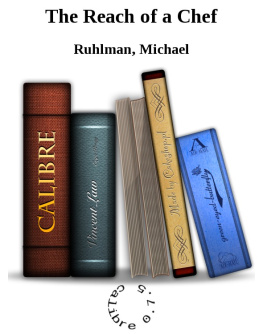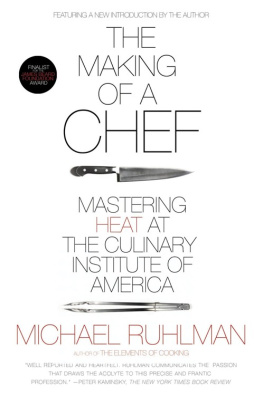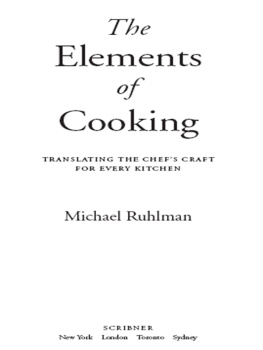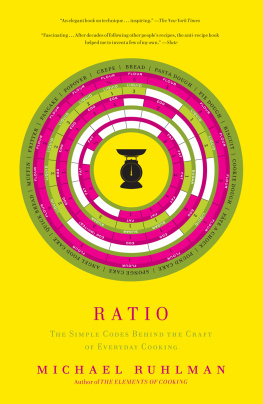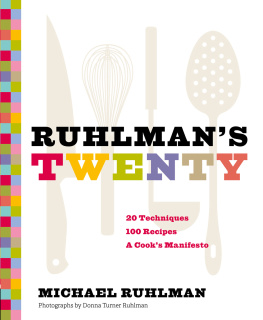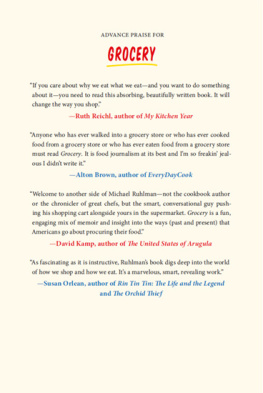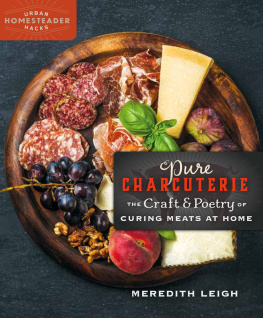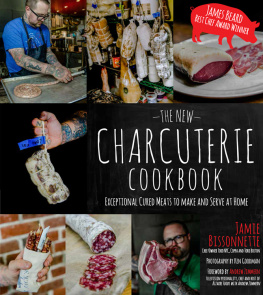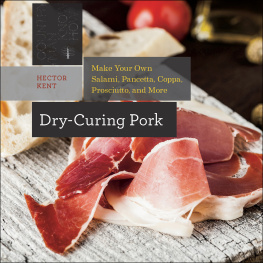
Also by Michael Ruhlman and Brian Polcyn
Charcuterie
OTHER FOOD BOOKS BY MICHAEL RUHLMAN
The Making of a Chef: Mastering Heat at the Culinary Institute of America
The French Laundry Cookbook (with Thomas Keller and Susie Heller)
The Soul of a Chef: The Pursuit of Perfection
A Return to Cooking (with Eric Ripert)
Bouchon (with Thomas Keller, Jeffrey Cerciello, and Susie Heller)
The Reach of a Chef: Professional Cooking in the Age of Celebrity
Under Pressure: Cooking Sous Vide (with Thomas Keller, Susie Heller, Amy Vogler, Jonathan Benno, and Cory Lee)
The Elements of Cooking: Translating the Chefs Craft for Every Kitchen
Ratio: The Simple Codes Behind the Craft of Everyday Cooking
Live to Cook (with Michael Symon)
Ad Hoc at Home (with Thomas Keller, Dave Cruz, Susie Heller, and Amy Vogler)
Ruhlmans Twenty: 20 Techniques, 100 Recipes, A Cooks Manifesto

To our mothers, Josephine Polcyn and Carole Ruhlman,
who taught us, by example, the love of cooking.
Contents

1. Getting Started

Making the Ancient New
S omething truly amazing has been underway in America for more than a decade now. The issue is so vast that for decades we lost sight of it, maybe even never saw it in this country until recently: the importance of food. If youd tried to argue that food was not important to one of our early ancestors, or to someone today who doesnt have enough of it, theyd look at you as if youd been living on another planet. But because food became so easily attained in the developed world, thanks to shipping, refrigeration, and infinite-shelf-life processing, we took it for granted. And we have only recently become aware of its importance on a national scale because our food supply has become imperiled and food-related illnesses, from bacterial contamination to diabetes, have begun to make us sick on an epidemic scale. The ramifications of this relatively new awareness are diverse: the FDA debates regulating how much salt companies can put in processed foods, physicians argue about whether or not food is as chemically addictive as alcohol or nicotine and why childrens food allergies have become as common as colds, and Congress debates farms subsidies. Weve turned chefs, once anonymous tradespeople, into celebrities. Food issues and cooking as sport have become common entertainment, food bloggers are attracting six-figure book deals, and farmers markets are flourishing throughout the country.
Amid this sturm und drang , a few truly wonderful changes have moved in like soothing waves through our culture. Changes so fine and unlikely that Brian and I believe that there has never been a better time in this countrys history to be a cook and to take pleasure in the cooking and sharing and eating of food.
America has always been a culture that embraces the new. But in the case of our food post World War II, new was not good for us. New was in fact bad in a lot of ways, and we have only in the past decade begun to recognize it. The trans fats in margarine, a healthy alternative to butter, actually made it unhealthy. We learned that there was high-fructose corn syrup in our bread and that the dyes added to processed food to make it more appealing were harming our kids. The antibiotics used to keep our cows healthy created a new bacterium that has killed and maimed.
But thanks to a few voices in the food world, old food and slow food have become new. And America has embraced this. We can only hope that, as the newness wears to inevitable age, we still sense the pleasure in the weathered surface and the clean, simple food that looks on the plate as it did coming out of the ground, that we recognize the power and importance of a well-made cheese, or a braised beef brisket, or potatoes mashed with whole milk, butter, and salt.
As ever, chefs have led the way in our new understanding, and their work and knowledge has filtered down into home kitchens. Alice Waters fostered a recognition of the value of naturally raised food we grow ourselves or that is grown by farmers near where we live when she opened Chez Panisse in 1971. Larry Forgione asked us to pay attention to our regional cuisines when he opened An American Place in 1983, celebrating a country so huge that what we grow or catch in one corner is in the other corner vastly different: grapefruit and grouper in the southeast, apples and salmon in the northwest, and sour cherries and walleye in between.
In Italy, Carlo Petrini, a writer and eco-provocateur, appalled by the proliferation of American fast food outlets in Rome, spearheaded a food movement called Slow Food in 1986. It has spread its promotion of naturally and sustainably raised and harvested food worldwide.
In the 1990s, more and more chefs began demanding excellence in their products and found farmers and foragers willing to work with them to achieve it. And soon that same search for excellence filtered down to everyone who liked to cook, and supermarkets worked to satisfy their customers with once unheard-of ingredients: morel mushrooms, habanero peppers, and ostrich eggs in the grocery store.
It was these changes that allowed us to publish Charcuterie: The Craft of Salting, Smoking, and Curing in 2005 with uncommon success. Yet the unlikeliness of that has to be underscored. Charcuterie is a book devoted to the French tradition of preserving meats by curing and confiting them, with recipes whose two principal ingredients are fat and salt. Fat and salt: villains number one and number two on American nutritionists Most Wanted list. At the same time, America had become obsessed with the fast and easy meal, and even 30-minute meals took too long. We also became terrified of germs and bacteria, getting rid of perfectly good wood cutting boards and buying up all manner of anti-bacterial soaps, dumping everything in the fridge if the power goes out for more than four hours. Into this culture, we brought a book not just devoted to animal fat and salt, but also reflecting a full-on love affair with them, a sweaty, torrid embrace of them. Moreover, many of the recipes take not 30 minutes, but rather days, sometimes even months, to prepareand recipes that ask you to add bacteria to your food, while telling you that if you dont do it right, it can kill you.
And chefs and cooks far and wide, bless them, embraced the book. Hundreds of readersand bloggerstook up the call to cure their own bacon and confit their own duck. This is a food culture Brian and I are very glad to be a part of. And it encouraged us to continue our exploration of the powers of salt and the majesty of the hog in salumi , the Italian version of the French craft we came to adorethe slowest food of all. But salumi and charcuterie are not the same craft with different names. Salumi is a narrower, more focused, and more difficult craft, one that should be approached the way one might hunt wild boar: with knowledge, respect, the proper tools, and the recognition that you might have a good day and you might not, you might catch something and you might come up empty-handedand that is part of the thrill of it. Because when you find that boar, and you will if you are willing to work for it, you can turn it into cinghiale sausages, the dry-cured wonders found throughout Italy, and the result is as thrilling as magic.
Next page

